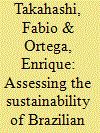| Srl | Item |
| 1 |
ID:
094940


|
|
|
|
|
| Publication |
2010.
|
| Summary/Abstract |
The aim of this paper is to make an emergy assessment of oleaginous crops cultivated in Brazil, available to produce biodiesel, in order to determine which crop is the most sustainable. This study evaluates conventional agro-chemical farms that produce rapeseed (canola), oil palm, soybean, sunflower and cotton. Rapeseed (canola) crop uses 40.41% of renewable energy and it is the most sustainable conventional oil crop; on the other hand, it is not widely produced in Brazil, probably due to climate restrictions or low market demand. The oil palm emergy indicators are contradictory: its emergy exchange ratio (EER) value is the lower, showing the possibility of fair exchange, and the low transformity value indicates high efficiency; however, it also has low renewability (28.31%), indicating a high dependency on agro-chemicals (basically fertilizers). Oil palm is a potential energy source due to its high agricultural productivity, but appropriate management is necessary to increase its sustainability and reduce the use of non-renewable resources.
|
|
|
|
|
|
|
|
|
|
|
|
|
|
|
|
| 2 |
ID:
124350


|
|
|
|
|
| Publication |
2013.
|
| Summary/Abstract |
While emergy analysis (i.e. emergy synthesis, environmental accounting) was developed in the early 1980s by H.T. Odum, building upon his seminal work outlining the energy basis for man and nature, the method is still developing. Some very important aspects of the method, such as the global baseline for renewable emergy and how the emergy yield ratio (EYR), a critical index for implicating the contribution of a process to society, is to be calculated are still under debate in the scientific community. This makes it all the more critical that when an emergy analysis is done all methodology is laid bare and justified. Unfortunately, Zhang et al. (2012. Energy Policy 42, pp 232-238) is deficient in doing so. In the response below I lay out the problems I observed in the paper and propose a revision to their analysis. I should note that no issues were found with the embodied energy portion of the analysis and the inconsistencies with accepted methodology were likely due to an unfamiliarity with the emergy method.
|
|
|
|
|
|
|
|
|
|
|
|
|
|
|
|